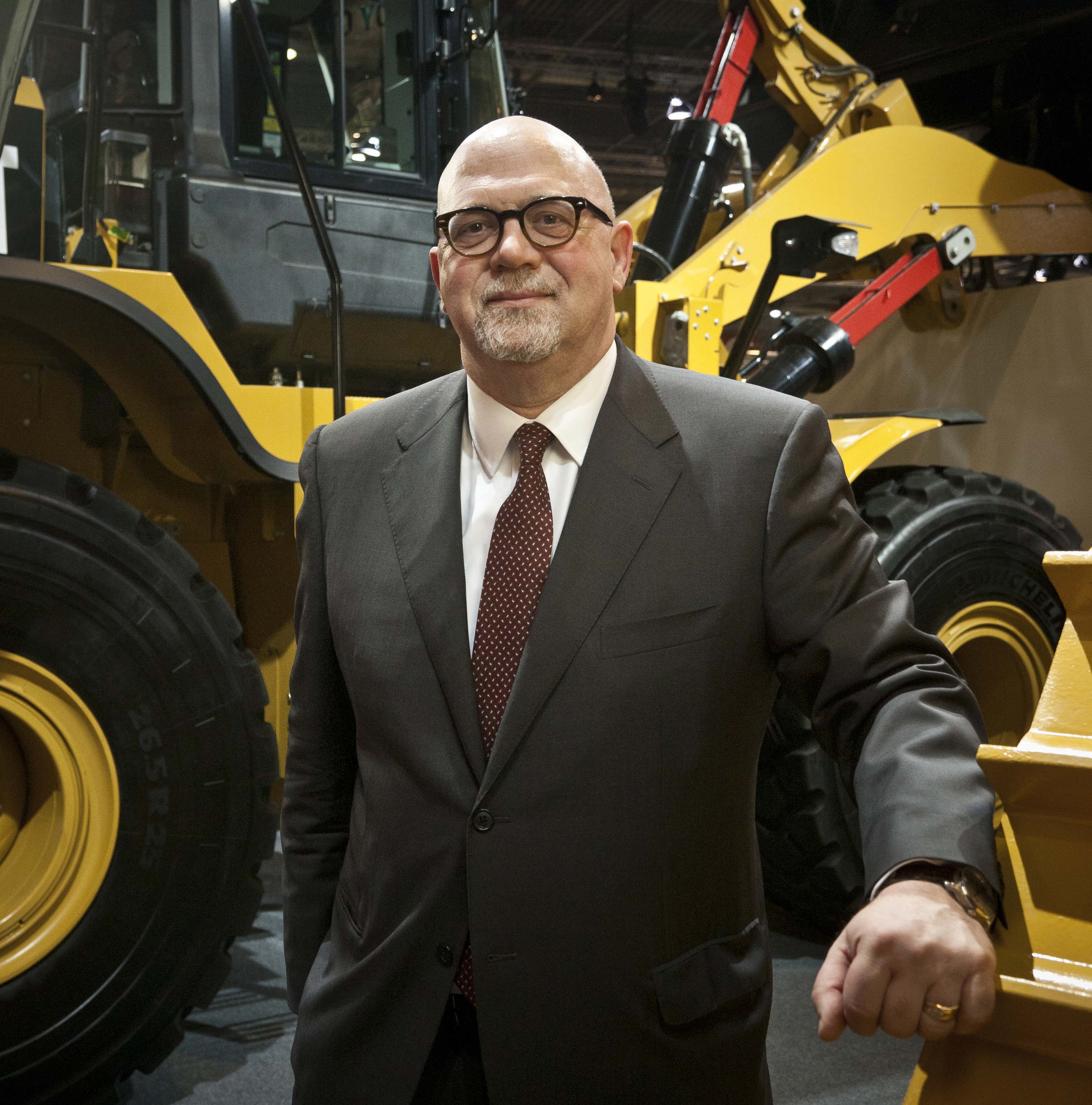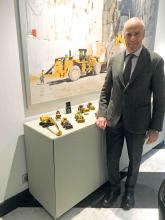
Having already spent 35 years at Caterpillar, and as the world’s biggest selling construction equipment manufacturer’s Vice President of Worldwide Sales & Marketing, Construction & Infrastructure, it makes sense to hear Paolo Fellin’s views on the quarrying market. Guy Woodford listened to them.
Paolo Fellin is very quick to sum up what he sees as quarry sector customers key priority. “Lower cost per tonne [of quarried material]. Quarrying is a highly competitive environment with high pressure on aggregates prices. Therefore, our customers typically strive for enhanced efficiency and lower costs per tonne for their quarry operations. In a high production environment such as quarry operations, small changes and improvements can have a real impact on the costs per tonne and the efficiency of the operation. Costs per tonne are impacted by many variables such as the correct equipment selection and fleet match, the job site set-up, the haul-road maintenance and the skills of the machine operators.”
Fellin, a highly personable native Italian, stresses that
“Fuel consumption represents approximately 30% of quarry customers operating costs. For Caterpillar, fuel efficiency is one of the major technological advances we have made to improve operating costs for our customers.
“Equipment in many operations idles by as much as up to 40% to 50%. When equipment is idling it is burning fuel without being productive. Typically, in idling mode, equipment burns on average five to six litres of fuel per hour. Reducing idling represents a massive fuel saving opportunity and most Cat equipment is equipped with ‘Idle Management Technology’, such as ‘Auto Idle Shut Down’ which shuts down the equipment after a defined time, such as five minutes.
“We also offer VisionLink [telematics] which monitors fuel consumption of equipment and fleet, along with equipment utilisation and idling time in order to identify gaps and opportunities for improvement.”
Fellin claims operators trained to be more fuel-efficient can improve equipment fuel efficiency and productivity by up to 25%. Caterpillar and its dealers offer dedicated operator training in order to enhance operator techniques and equipment usage.
Having the “right machine for the right job” is, says Fellin, also important for fuel efficiency. He says Caterpillar product specialists and dealer experts consult with customers for correct equipment selection and machine configuration for the application.
Finally, Fellin explains how Caterpillar and its dealers’ system application experts conduct quarry sites analysis and assist customers in how best to increase fuel efficiency and lower the cost per tonne. The international construction equipment manufacturing market is just as highly competitive as the quarrying industry. So how does Fellin think Caterpillar stands out from the heavyweight OEM crowd? “Caterpillar is one of the few manufacturers in the quarry industry that offers a complete product line for quarry operation right from drills, rigid frame trucks, articulated trucks, wheeled loaders, excavators as well as support equipment such as track -type tractors, motor graders.
“It also benefits from a dedicated sub-segment product strategy that anticipates the specific needs and requirements of the different quarry segments and applications. As an example, for the wheeled loaders, the Cat 988 is available in different configurations such as the 988 BH for block handling, the 988 Aggregate Handler for stockpiling materials and the 988 with a rock bucket for face loading.”
Caterpillar’s current best-selling models include some traditional proven favourites as well as some newer models, as Fellin illustrates. “For loading units (crushed rock), the global flagship is the Cat 988 wheeled loader which celebrated its 50th anniversary in 2013. The Cat 988K is the latest version. Over the past 50 years, Caterpillar has sold in excess of 20,000 units of the Cat 988 wheeled loader.
“Caterpillar is also extremely well positioned with its excavator range, with the Cat 336 up to the Cat 390 models. With the recent launch of the Cat 336F XE hybrid, Caterpillar sets a new standard for fuel efficiency in this segment.
“The rigid frame trucks which Caterpillar started building in 1963 with the Cat 769 are another success story. In the current product line, the most popular units for the quarry segment are the Cat 770 up to the Cat 777. For haul roads where a rigid frame truck is not the best solution, Caterpillar offers a full range of articulated trucks.
“For the yard loader and aggregates rehandling Cat medium wheeled loaders are very well accepted by our customers, especially the 980 class H, K and recently launched M series.”
Fellin says that for emerging countries and in mainland China, Caterpillar’s 320D2 series excavator is another popular choice for the small and medium aggregates quarry owners.
Of the current quarrying sector equipment sales market, Fellin says North America, Europe, Africa and the Middle East remain “large contributors” to Caterpillar’s success in this market.
“Globally, the aggregates and heavy construction markets represent a mixed picture. North America is beginning to rebound, while South America, Europe, Africa, Middle East, and Asia-Pacific are flat to slightly declining.
“U.S. Geological Survey reports that aggregate production was up 7% in 2014 compared to 2013. Most of it was driven by private construction spending. However, we believe all markets will experience growth in the next few years. Public demand for new infrastructure and repair of existing infrastructure will cause governmental agencies to fund infrastructure projects.
“We expect world economic growth to only improve modestly in 2015. There is a strong co-relationship between economic growth, construction activities and quarrying and we anticipate the demand for quarrying and heavy construction equipment to follow the demand for construction material generated by housing, residential and construction with a spike / increase from infrastructure activities.”
Fellin says Asia offers exciting growth potential for leading quarry sector OEMs such as Caterpillar.
“We expect urbanisation in China and India and the upgrading of ageing infrastructure in the US will make these the largest growth markets in the years ahead.
“Aggregate producers in many countries have delayed replacing equipment fleets due to economic uncertainty therefore the fleets are ageing. Equipment demand is likely to accelerate substantially as economic conditions improve.
“Future growth prospects still look promising for Asian countries such as India, Vietnam, Indonesia and Thailand, where construction spending is expected to grow at above the regional average of 4.4 percent over the next five years.
“Another case of solid growth is the United States, which has shown clear signs of recovery in 2014, with an economic growth of 2.2 percent in 2014 and an expected 3.1 percent in 2015. The sheer size of the US infrastructure replacement and upkeep continues to drive growth.” Fellin also believes massive infrastructure projects in the Africa Middle East region, such as the airport project in Istanbul or the announcement that a new capital will be built East of Cairo at a cost of US$45 billion, will fuel its construction industry.
In Europe, overall business for aggregates is expected to stay flat, he forecasts, although Fellin believes business in sub-segments such as block handling should remain strong due to robust demand for marble, especially in China and the Middle East. Fellin explains how Italy and Turkey, who are the leading producers of marble, are benefiting from this trend.
Heavy investment in research and development has helped Caterpillar establish itself as the number one selling construction equipment manufacturer, including its ongoing innovation in its quarry sector equipment.
Fellin acknowledges its importance to Caterpillar’s long-term goals within both the quarrying and overall construction equipment sectors. “Caterpillar’s investment in R&D has remained strong through the uncertain economic times. Emissions regulations drove some massive R&D efforts in the last seven to eight years. Now that those requirements have been met, we will pursue other opportunities to improve efficiency and continue our leadership as the lowest cost per tonne equipment supplier.”







